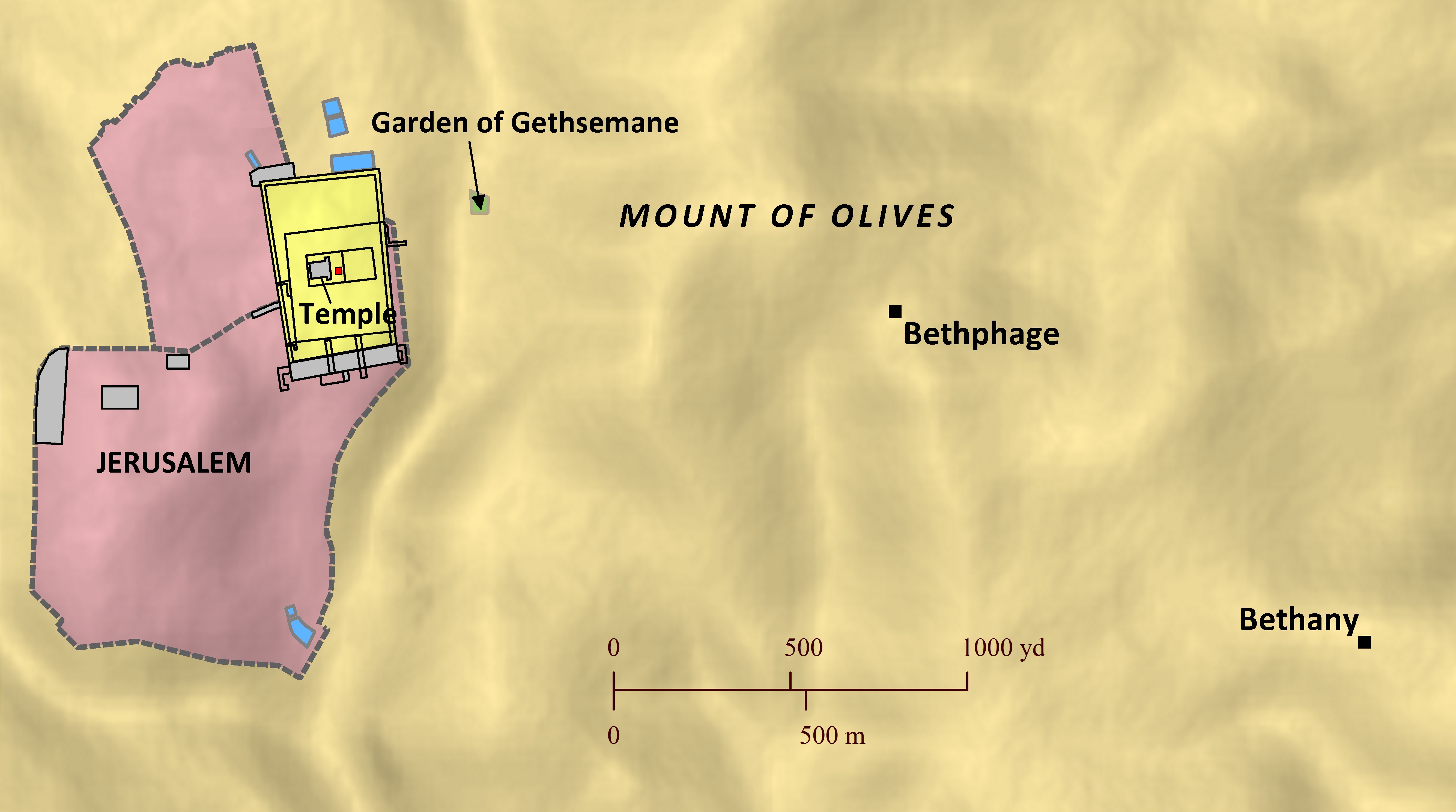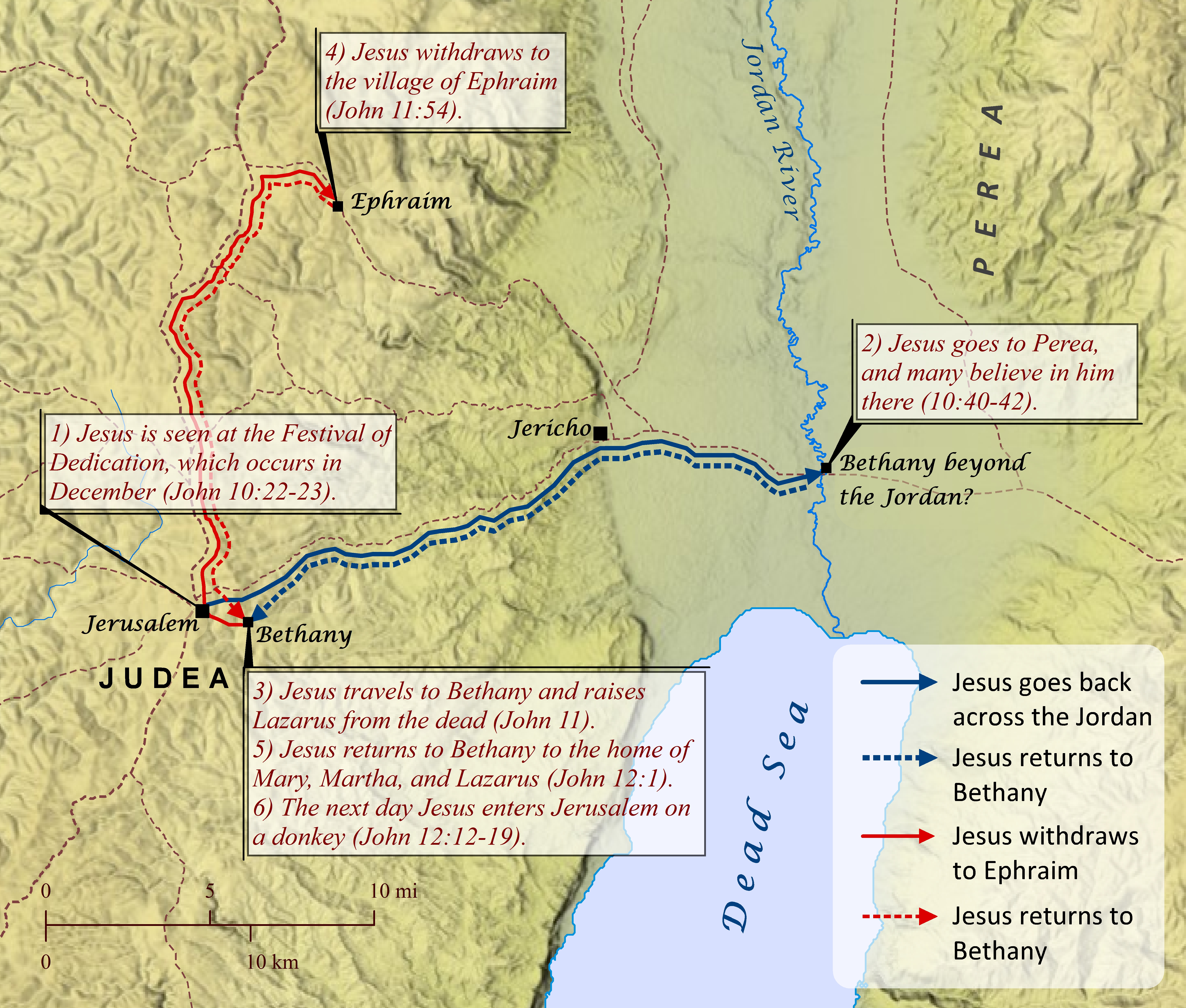Note: This view shows ‘verses’ which are not natural language units and hence sometimes only part of a sentence will be visible—click on any Bible version abbreviation down the left-hand side to see the verse in more of its context. Normally the OET discourages the reading of individual ‘verses’, but this view is only designed as a tool for doing comparisons of different translations—the older translations are further down the page (so you can read up from the bottom to trace the English translation history). The OET segments on this page are still very early looks into the unfinished texts of the Open English Translation of the Bible—please double-check these texts in advance before using in public.
AICNT Therefore, Jesus came to Bethany six days before the Passover, where Lazarus was [[who had been dead]],[fn] whom Jesus[fn] had raised from the dead.
OEB Six days before the Passover Jesus came to Bethany, where Lazarus, whom he had raised from the dead, was living.
WEBBE Then, six days before the Passover, Jesus came to Bethany, where Lazarus was, who had been dead, whom he raised from the dead.
WMBB Then, six days before the Passover, Yeshua came to Bethany, where Lazarus was, who had been dead, whom he raised from the dead.
NET Then, six days before the Passover, Jesus came to Bethany, where Lazarus lived, whom he had raised from the dead.
LSV Jesus, therefore, six days before the Passover, came to Bethany, where Lazarus was, who had died, whom He raised out of the dead;
FBV Six days before the Passover Jesus went to Bethany, to the home of Lazarus who had been raised from the dead.
TCNT Six days before the Passover, Jesus came to Bethany, where Lazarus was, the man [fn]who had died and whom Jesus had raised from the dead.
T4T Six days before the Passover celebration started, Jesus arrived in Bethany village, along with us. That was where Lazarus lived. He was the man Jesus previously caused to be alive again after he died.
LEB Then, six days before the Passover, Jesus came to Bethany, where Lazarus was, whom Jesus had raised from the dead.
BBE Then, six days before the Passover, Jesus came to Bethany where Lazarus was, whom Jesus had made to come back from the dead.
Moff Six days before the festival, Jesus came to Bethany, where Lazarus stayed (whom Jesus had raised from the dead).
Wymth Jesus, however, six days before the Passover, came to Bethany, where Lazarus was whom He had raised from the dead.
ASV Jesus therefore six days before the passover came to Bethany, where Lazarus was, whom Jesus raised from the dead.
DRA Jesus therefore, six days before the pasch, came to Bethania, where Lazarus had been dead, whom Jesus raised to life.
YLT Jesus, therefore, six days before the passover, came to Bethany, where was Lazarus, who had died, whom he raised out of the dead;
Drby Jesus therefore, six days before the passover, came to Bethany, where was the dead [man] Lazarus, whom Jesus raised from among [the] dead.
RV Jesus therefore six days before the passover came to Bethany, where Lazarus was, whom Jesus raised from the dead.
SLT Then Jesus, six days before the pascha, came to Bethany, where was Lazarus the dead, whom he raised from the dead.
Wbstr Then Jesus, six days before the passover, came to Bethany, where Lazarus was who had been dead, whom he raised from the dead.
KJB-1769 Then Jesus six days before the passover came to Bethany, where Lazarus was which had been dead, whom he raised from the dead.
KJB-1611 ¶ Then Iesus, sixe dayes before the Passouer, came to Bethanie, where Lazarus was, which had bene dead, whom hee raised from the dead.
(¶ Then Yesus/Yeshua, six days before the Passover, came to Bethanie, where Lazarus was, which had been dead, whom he raised from the dead.)
Bshps Then Iesus, sixe dayes before the Passouer, came to Bethanie, where Lazarus had ben dead, whom he raysed from death.
(Then Yesus/Yeshua, six days before the Passover, came to Bethanie, where Lazarus had been dead, whom he raised from death.)
Gnva Then Iesus, sixe dayes before the Passeouer, came to Bethania, where Lazarus was, who died, whom he had raised from the dead.
(Then Yesus/Yeshua, six days before the Passover, came to Bethania, where Lazarus was, who died, whom he had raised from the dead. )
Cvdl Sixe dayes before Easter came Iesus vnto Bethanye, where Lazarus was, which was deed, whom Iesus raysed vp from the deed.
(Six days before Easter came Yesus/Yeshua unto Bethanye, where Lazarus was, which was deed, whom Yesus/Yeshua raised up from the deed.)
TNT Then Iesus sixe dayes before ester came to Bethany where Lazarus was which was deed and who Iesus raysed from deeth.
(Then Yesus/Yeshua six days before ester came to Bethany where Lazarus was which was deed and who Yesus/Yeshua raised from death. )
Wycl Therfor Jhesus bifor sixe daies of pask cam to Bethanye, where Lazarus hadde be deed, whom Jhesus reiside.
(Therefore Yhesus before six days of passover came to Bethanye, where Lazarus had be deed, whom Yhesus raised.)
Luth Sechs Tage vor Ostern kam JEsus gen Bethanien, da Lazarus war, der Verstorbene, welchen JEsus auferwecket hatte von den Toten.
(Sechs days before/in_front_of Easter/Passover came Yesus to/toward Bethanien, there Lazarus was, the/of_the Verstorbene, which_(ones) Yesus resurrected had from the killing(n).)
ClVg Jesus ergo ante sex dies Paschæ venit Bethaniam, ubi Lazarus fuerat mortuus, quem suscitavit Jesus.[fn]
(Yesus therefore before six days Paschæ he_came Bethaniam, where Lazarus had_been dead, which raised Yesus. )
UGNT ὁ οὖν Ἰησοῦς πρὸ ἓξ ἡμερῶν τοῦ Πάσχα, ἦλθεν εἰς Βηθανίαν, ὅπου ἦν Λάζαρος, ὃν ἤγειρεν ἐκ νεκρῶν Ἰησοῦς.
(ho oun Yaʸsous pro hex haʸmerōn tou Pasⱪa, aʸlthen eis Baʸthanian, hopou aʸn Lazaros, hon aʸgeiren ek nekrōn Yaʸsous.)
SBL-GNT Ὁ οὖν Ἰησοῦς πρὸ ἓξ ἡμερῶν τοῦ πάσχα ἦλθεν εἰς Βηθανίαν, ὅπου ἦν ⸀Λάζαρος, ὃν ἤγειρεν ἐκ νεκρῶν ⸀Ἰησοῦς.
(Ho oun Yaʸsous pro hex haʸmerōn tou pasⱪa aʸlthen eis Baʸthanian, hopou aʸn ⸀Lazaros, hon aʸgeiren ek nekrōn ⸀Yaʸsous.)
RP-GNT Ὁ οὖν Ἰησοῦς πρὸ ἓξ ἡμερῶν τοῦ Πάσχα ἦλθεν εἰς Βηθανίαν, ὅπου ἦν Λάζαρος ὁ τεθνηκώς, ὃν ἤγειρεν ἐκ νεκρῶν.
(Ho oun Yaʸsous pro hex haʸmerōn tou Pasⱪa aʸlthen eis Baʸthanian, hopou aʸn Lazaros ho tethnaʸkōs, hon aʸgeiren ek nekrōn.)
TC-GNT Ὁ οὖν Ἰησοῦς πρὸ ἓξ ἡμερῶν τοῦ Πάσχα ἦλθεν εἰς Βηθανίαν, ὅπου ἦν Λάζαρος [fn]ὁ τεθνηκώς, ὃν ἤγειρεν ἐκ [fn]νεκρῶν.
(Ho oun Yaʸsous pro hex haʸmerōn tou Pasⱪa aʸlthen eis Baʸthanian, hopou aʸn Lazaros ho tethnaʸkōs, hon aʸgeiren ek nekrōn. )
Key for above GNTs: yellow:punctuation differs, red:words differ (from our SR-GNT base).

